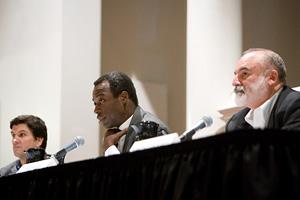By last summer, the Amherst endowment had reached an all-time high of $1.7 billion, representing a 5 percent increase in value during the fiscal year that ended June 30, 2008. “We actually felt quite good,” says Bill Ford ’83, a member of the Amherst Board of Trustees and chair of its investment committee. “And then, the world turned against us.”
Ford spoke on Tuesday, Feb. 17, at an open forum for students, faculty and staff in a crowded Johnson Chapel. He, along with two other trustees—board chairman Jide Zeitlin ’85 and budget and finance committee chairman Steven Gluckstern ’72—discussed and answered questions about the college’s endowment, investment strategy, overall budget and pending budget cuts. They tried to explain what has happened over the past several months and how the college will move forward.
 Left to right: Amherst College trustees Bill Ford '83, Jide Zeitlin '85 and Steven Gluckstern '72 answer questions from the Amherst Community during the Feb. 17 open forum. Hear audio and watch slide show presentations from the meeting (login required). |
The endowment fell 26 percent in value, to $1.26 billion, during the first half of the current fiscal year, which began July 1, 2008. Until that happened, the college’s highly diversified portfolio had kept it from dramatically feeling the ups and downs of the market. “Diversification,” Ford said, “which is your port in the storm, so to speak, didn’t work, for the first time in recent memory.”
And the worst is likely not over. The college is predicting the endowment to be down 30 percent by the end of this fiscal year. Projections are for no growth next year and 5 percent growth the following year. Assuming those numbers, “you can see a very, very horrible picture” if spending were to remain the same, Gluckstern said: “You’d run the college out of business.”
The total budget for the current fiscal year is around $155 million, up from about $80 million 10 years ago. (The increases to the budget followed gains in the endowment.) About half of the $155 million goes to salaries and benefits for faculty and staff members. The other big chunk of the pie—21 percent—is for student aid and academic awards, Gluckstern explained.
The college is now undergoing an “exercise in belt-tightening,” as Gluckstern put it. Earlier this winter, every department at the college was asked to propose immediate 5 percent and 10 percent budget cuts; salary cuts and layoffs were off the table. In addition, the college announced a salary freeze for next fiscal year and began to more carefully review whether to fill open positions. Now, every department is planning for an additional 5 percent in non-salary budget cuts.
But, Gluckstern said, “you still have a picture that is untenable.” Long-term plans must allow for growth in such areas as financial aid and the faculty, he said, and for things like new buildings, “but the pattern with which we enjoyed growth for the last 10 years cannot sustain us for the next 10 years.”
In large part, that is because the percentage of the college’s budget that comes from the endowment “has grown dramatically from the low 20s to 35 percent this year,” Ford said. “The budget’s dependency on the performance of the endowment and financial markets is much, much greater than it was only 10 years ago.”
During the question-and-answer period, a student asked whether it’s reasonable to assume that cuts will be made to the two biggest pieces of the budget pie—salaries and benefits for staff and faculty and financial aid. “No, I don’t think that’s a fair assumption,” Gluckstern replied. “It’s not a foregone conclusion that there are less faculty, less staff, less student aid ... I think it’s a fair statement that over a 10-year period, the growth in all those areas that we might have wanted to have—that we can’t have all that growth.”
In response to another question, Zeitlin said the board has no specific plan for what to cut in the short term. “We almost certainly will, in some form or another, slow down the rate of growth in compensation,” he said. “I don’t know what form that takes.” He promised that the board has no secret list of what to cut. “The board doesn’t have an agenda here other than to make sure within 10 years we get back to financial equilibrium. We don’t have answers. Those answers have got to come from you.” —Emily Gold Boutilier
Members of the Amherst community are invited to hear audio and watch slide show presentations from the meeting (login required).